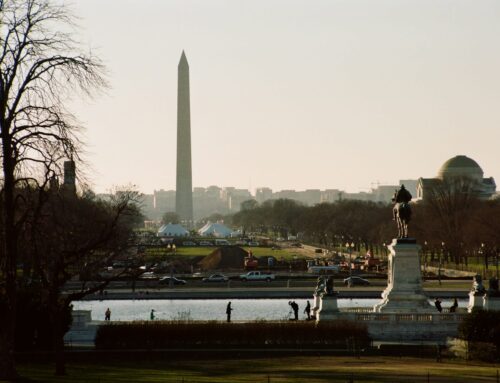Earlier this week, the Senate passed its version of the jobs bill—a bill which is flawed from a transportation and taxpayer perspective. Very quickly a tempest arose between the Senate and the House over how to distribute funds from two programs in the 2005 surface transportation bill (which the jobs bill would extend until the end of 2011): Projects of National and Regional Significance and the National Corridor Infrastructure Improvement Program. In the 2005 bill, both of these programs were completely earmarked, and contained a portion of the funding for the infamous and since-defunct “Bridge to Nowhere” in Alaska.
For an List of All Earmarks in These Programs: CLICK HERE
Percentage of Funds States Received from National Corridors and Projects of National and Region Siginicance in 2005 Surface Transportation Bill
|
Percentage of Funds States Received from National Corridors and Projects of National and Region Siginicance in 2005 Surface Transportation Bill CA 29.78% IL 16.22% LA 6.17% WA 5.90% OR 4.29% OK 3.89% VA 3.89% AR 3.85% TN 2.91% MN 2.68% NJ 2.68% NY 2.68% WV 2.15% DC 2.01% WI 1.61% CO 1.42% PA 1.34% SC 1.34% CT 0.94% AK 0.80% OH 0.80% MI 0.54% IN 0.49% NM 0.38% MD 0.27% KY 0.22% MS 0.22% TX 0.22% IA 0.20% AZ 0.08% |
The House raised a stink because the Senate bill continues funding for these programs in the same ratio they were distributed back when the 2005 bill was passed. The Senate bill would make $932 million available for these programs through the end of 2011. Only 30 states will receive any of that money, with only a few states taking home the lion’s share of the cash. California will receive by far the greatest share, receiving 30% of these funds. Add Illinois (16%), Louisiana (6%), and Washington (6%) and four states will receive 58% of the funds. Add Oregon, Oklahoma, Virginia, and Arkansas—all of which receive 4%—and just eight states receive three-quarters of this money.
The House, in its bill, would distribute these funds on a competitive basis and make all states eligible to receive some share of the cash: “the Secretary shall allocate funds authorized to be appropriated…for the projects of national and regional significance program on the basis of a competitive selection process.” A similar provision appears for the National Corridor Program.
As one looks at the states that benefitted most from these earmarks in the 2005 bill, it’s easy to see the political influence that was at play. These earmarks were distributed based less on the importance of the projects proposed and more on the political influence of the members who were fighting for the earmarks. It is interesting to note that two of the projects below are not even active, and their funding has been or may be “reprogrammed” for other uses; and that three of the members involved are no longer serving in Congress.
California’s dominance is largely the result of one man: former Rep. Bill Thomas (R-CA), who at the time was the Chairman of the House Ways and Means Committee. This perch allowed him to pull down $630 million worth of earmarks (of the $1.1 billion that went to California) in these two accounts alone for his hometown of Bakersfield.
Illinois received the second most of any state from these programs in the 2005 bill, largely the result of the political might of former Speaker of the House Dennis Hastert (R-IL), who inserted two earmarks worth a total of $207 million (of Illinois’ $604.5 million) for the infamous and now dead “Prairie Parkway” project, from which Hastert is alleged to have profited in land deals after the bill was passed.
Louisiana came in third on this list, largely the result of funding for the I-49 project, which received over $200 million in earmarks (of Louisiana’s $230 million total) from these two programs. Former Rep. Richard Baker (R-LA) was an outspoken champion of this project, a member of the House Transportation and Infrastructure Committee, and a member of the House-Senate Conference that negotiated the final form of the bill. At the time he was quoted as saying: “I hope that this opportunity granted to me will also mean good news for the state, because as dean of the Louisiana delegation I take it as a duty to fight for I-49, I-69, and every project important to people in each congressional district.” (US Fed News, May 26, 2005). Sen. David Vitter (R-LA) is also a champion of this project, serves on the Senate Environment and Public Works and Commerce, Science, and Transportation Committees, and was a member of the House-Senate Conference.
Washington was also a big winner in the earmarks it received from these programs. The state received just two earmarks, but they were worth $220 million for the Alaskan Way Viaduct project. Sen. Patty Murray (D-WA)—though certainly not the only champion for this project—was ranking member of the Transportation Subcommittee of the Senate Appropriations Committee (she is now the Chair). Rep. Dave Reichert (R-WA), also a project champion, served on the House-Senate Conference.
Alaska did not receive a great deal of money from these programs. In fact, it received only one earmark for $30 million, but it is worth mentioning because that earmark was for the now-infamous “Bridge to Nowhere.” The bulk of the earmark funding for this project came elsewhere in the bill.










